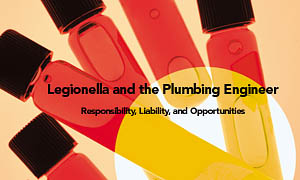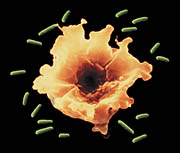
Issue: 2/02
So much of Legionella has to do with plumbing systems that it's fair to say plumbing engineers play a greater role in Legionnaires' Disease prevention than do doctors, infection control professionals, hvac engineers, water treatment specialists, microbiologists and epidemiologists. Only facility managers have equal or greater responsibility.
With the responsibility come liability and opportunities. Plumbing engineers who acquire Legionella knowledge will avoid designs and specifications that could lead to Legionella growth, and thus lawsuits, and may want to expand their businesses by offering services related to Legionella.
Reducing Your Liability
Ronnie Penton, an attorney with significant Legionnaires' Disease case experience, has stated, "Every employee of the institution is on trial during litigation of a Legionnaires' Disease outbreak. Trial lawyers want to know about every pipe, valve and tank between the municipal water source and point of use."Attorneys are indeed interested in the details. In a lawsuit involving a hotel, an attorney deposing a plumbing engineer asked numerous questions--pages of them--about aspects of the system design (e.g., potential dead-leg areas) that could have been conducive to Legionella growth. Several minutes of questioning were devoted solely to one valve--a check valve installed between a potable and nonpotable system--as to whether it was an acceptable backflow device.
As awareness increases about the role plumbing systems play in transmission of Legionella bacteria, plumbing engineers could be named in more and more Legionella-related lawsuits, even in suits involving properly designed systems, since those systems can become contaminated with Legionella if they are not operated and maintained to minimize Legionella growth. The best protection for plumbing engineers is to design systems to minimize conditions conducive to Legionella growth, include Legionella-preventive measures in operating and maintenance specifications, and document Legionella-preventive recommendations that were rejected by the owner.

Offering Risk Assessment Services
Since January 2001, hospitals accredited by the Joint Commission on Accreditation of Healthcare Organizations (JCAHO) have been required, under Standard EC 1.7, to "reduce the potential for organizational-acquired illness?anaging pathogenic biological agents in cooling towers, domestic hot water, and other aerosolizing water systems." An interim guide document for complying with EC 1.7 instructs health care facilities to conduct a risk assessment of potential sources of Legionella and develop a management plan for maintenance and operation of water systems.A risk assessment is conducted to determine conditions that may be conducive to growth of Legionella and other waterborne pathogens. The domestic water system, cooling towers and decorative fountains should be inspected. Policies for other aerosolizing devices should also be evaluated. Sampling cooling towers and potable water for Legionella is not required by JCAHO, but test results may provide useful information, indicating specific maintenance required.
A key part of risk assessments is evaluating visible domestic water piping, and possibly plumbing drawings, to check for dead legs and other situations conducive to Legionella growth. Plumbing engineers could thus play an integral role in such services, either directly to owners or as a subcontractor to a Legionella specialist, water treatment company or environmental consulting firm.
Hospitals aren't the only organizations seeking risk assessments for Legionella. Ever since outbreaks of Legionnaires' Disease associated with the Ford Motor plant in Ohio and a high-rise tower in Las Vegas occurred last year, operators of manufacturing plants, large hotels and office buildings have begun to see that a proactive approach to Legionnaires' Disease, though not required, may make good sense.
Plumbing engineers who offer risk assessments directly to owners need to disclose the limitations of the assessment. You should be specific in describing the services you are not providing as well as the ones you are. For example, you should state in writing that your assessment pertains only to the plumbing system, advising the owner that cooling towers, decorative fountains, whirlpool spas and other devices are also potential sources of Legionella contamination.
Rather than simply providing a report of the risk assessment findings, you should consider offering a full management plan for waterborne pathogens for the systems you evaluated, outlining design, operating and maintenance measures that will minimize Legionella growth.
Helping to Solve Legionella Problems
Plumbing engineers can also provide services related to domestic water systems that are contaminated with Legionella. An investigation of a contaminated system would include an evaluation of the plumbing design. A plumbing engineer's help may also be needed in conjunction with emergency disinfection of the system. Plumbing engineers who offer problem-solving services need to become familiar not only with Legionella-preventive design factors, but also with various Legionella disinfection technologies for plumbing systems.Partnering With Other Professionals
An owner that wants a Legionella risk assessment will likely call the water treatment company servicing its cooling towers, an environmental consulting firm that has done work previously at the facility, or a Legionella specialist. Plumbing engineers may therefore find a niche as a subcontractor, because each of these three may need help in evaluating the plumbing system. For example, for some of my Legionella consulting projects, I seek help from a plumbing engineer who is knowledgeable of Legionella preventive measures and located in the vicinity of the project.Plumbing engineers that are Legionella-trained and have regular contact with facility managers may have the opportunity to provide risk assessments directly to owners. If so, the plumbing engineer may need to subcontract the cooling tower inspection to a water treatment company or a Legionella consultant. The plumbing engineer may also want the help of a Legionella consultant to conduct sampling, review data, and provide a management plan.
In sum, plumbing engineers who are knowledgeable about Legionella can reduce their liability, expand their business and even save lives


